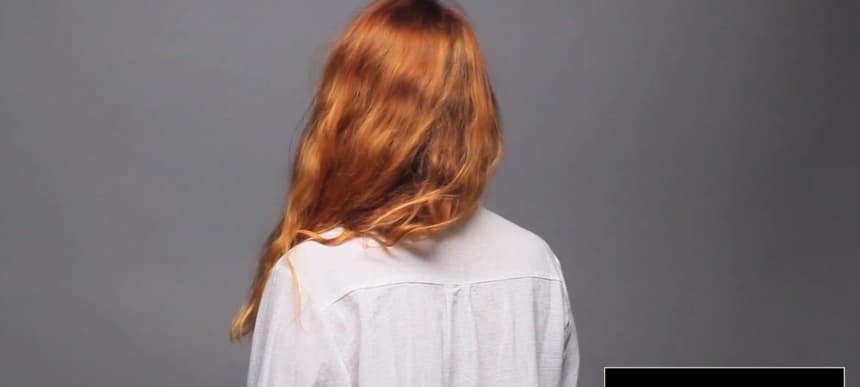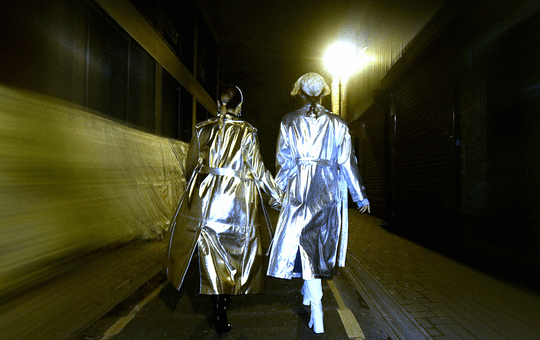
Holly Herndon interview: "Computers compute."
As we’re saying our goodbyes at the end of our interview, Holly Herndon pipes up, “I hope I didn’t talk about tech too much.” To be honest, my intention hadn’t been to talk about technology beyond a surface level – being confronted by a wall of text discussing monitoring, gear fetishism, engineering processes and other technological aspects of music making can rarely be anything other than alienating to somebody that isn’t a producer themselves. Holly didn’t talk about anything like that, though, yet technology was also the topic that dominated our discussion. We didn’t speak about anything technical as such, but about the role of technology in modern day performance, a subject that she speaks about with an unbeatable enthusiasm and total optimism about its role in the future.
Holly Herndon is an electronic musician and performance artist. In fact, she’s not just an electronic musician – this tag seems a little too broad. Rather, she’s a computer composer and sound artist, one who honours compositional traditions established by artists like Karlheinz Stockhausen and diligently carried through to the present day. She uses a laptop for both making music and for live performance, and has a deep, philosophical interest in this machine’s role in modern society, describing it as “the most intimate instrument we have at our disposal.” She’s also an academic, having recently completed a Masters in Electronic Music at Mills College, and who is now pursuing a PhD at Stanford University, California. On ‘Movement’, her recently released album for RVNG Intl., Herndon experiments with genuinely original and genuinely innovative techniques to create a record that marries her academic, experimental background with the dancefloor-focused, sound system-worshipping world of techno. These two sensibilities come from Holly’s movements in life, which took her from her hometown in Northeast Tennessee to Berlin, where she spent years involved in the party circuit.
Holly Herndon – Dilato
I was curious to know how somebody from Johnson City, Tennessee, only a few towns over from Dolly Parton, could end up producing something as thoroughly electronic as ‘Movement’. “My first exposure to electronic music would be the first time I went to Berlin,” she tells me over Skype. “I was 16 years old, I went on a class trip.” It was there that she heard Eurotrance, an everyday fact of life on the continent, but an alien concept to somebody from the home of bluegrass and country music. “I was like: ‘woah. This is insane. This is so euphoric I feel like my brain’s gonna explode.’” What’s perhaps more interesting is how somebody from this background might discover the more experimental side of things. Holly pauses when I ask her. “That’s a good question. I think I have always been a naturally curious person, wanting to take things to their natural conclusion, or to see the next level and the next level.” At 18, she returned to Berlin on an exchange visit, spending a year in the city. Here, like countless other visitors to the city, she discovered clubbing, eventually working in clubbing institution Cookies and becoming fully immersed in the dance music culture. “I think there’s a lot of intersection between dance music and experimental music,” she says, “and I think that’s a natural progression.” This attitude shows on ‘Movement’, where odd, spacious tracks laden with white noise and heavy vocal processing sit comfortably alongside jacking house tracks and acid techno joints. Even opening track Terminal has a rippling 4/4 rhythm, despite lacking in both beats and bass. None of these can be described as ‘conventional’, however: “If you give people something they can undulate their body to, you can throw in some really weird stuff, and people will still understand that because they’re responding to the rhythm.”
“If you give people something they can undulate their body to, you can throw in some really weird stuff, and people will still understand that because they’re responding to the rhythm.” – Holly Herndon
Holly eventually decided to return to her studies and apply to her Masters program, working on her album after graduating. She got a job working in a children’s museum to support herself, developing interactive media exhibits, but found that it was too time-consuming, and decided to pursue her music full-time through her PhD program. It’s when speaking about academia, about the research and development of new musical possibilities, that she becomes liveliest. Holly’s music pushes the capabilities of modern technology to the limit, and her studies allow her to be at the cutting edge of this world, granting her access to the most contemporary tools available. “Frankly, before I moved here, I wasn’t even that interested. And then I moved here and I was like, ‘woah, these people are doing crazy stuff.’”
For all the vague allusions to “future” music that float around the music press, it’s rare to encounter an artist that can legitimately claim to be at the forefront of what the future offers. Yet there is little constructive discourse surrounding the future of live performance – there is still a stigma behind the laptop’s role in this area, even though you’d be hard pressed to find an electronic musician that doesn’t incorporate one into their show nowadays. Whether it’s “real” DJs sneering at an Ableton performance or a band hiding their laptop under a table whilst they play a MIDI keyboard, artists have been both keen to embrace the possibilities of the laptop yet quick to downplay its significance. Holly is happy to perform with her laptop, but concedes that there is progress to be made. “I definitely think that what we need to do is figure out how to make them engaging and work in a live performance situation.” Is it just a case of refining what we already have at our disposal? “Right, and finding new ways to make it personal and gestural. And whatever it is, get to the crux of what an audience wants to see. I think that it’s changing – the status quos of what people expect out of a performance, they change with generations, and I think we should just be flexible about researching what the needs are and figuring out how to meet those needs.”
Holly Herndon & Bruce Rameker – Dilato live at Roulette, Brooklyn
One reason they may not be seen as engaging is that people are using them broadly to emulate pre-existing forms. Software emulates turntables, a digital synth emulates an analogue one – it’s incredible, but where’s the newness? “If you look at when Moog was developing the early synthesisers, you didn’t have to have a keyboard attached to it, you could just use a knob to go between frequencies. And you didn’t have to use western intonation, but that’s what we did, because that’s what something that was familiar…I really think that that’s human nature: we have this new technology, how can we get it to do things that we’ve done before? But I think that’s early adoption, and then people get comfortable with it, and then they start exploring the real capabilities and the real possibilities.”
Holly mentions network performance as one of these possibilities – performances that don’t even require one musician to be in the same space as another, but who are projected through a network. She describes a new protocol that she has encountered in her studies called OSC, which is “a way to communicate via network between computers, between devices like phones, or iPads, or whatever. You can send audio files, you can send MIDI files, so this wireless communication, not bound to location over a network, is a completely new way of being able to communicate with other performers and with your audience in a way that’s never happened before. And I don’t think it’s been fully explored or worked out, but I’ve seen some performances which show that there are new things we can do. You can’t do this with a modular synthesiser – you can’t communicate to another modular synthesiser in Tokyo and send different messages back and forth.”
“That’s human nature: we have this new technology, how can we get it to do things that we’ve done before? But…then [we] start exploring the real capabilities and the real possibilities.” – Holly Herndon
“Another thing is, I started using a programming language called ChucK. It’s a really interesting way of dealing with time in music. It’s set up for real time coding, which is a very different way of writing music or performing music than pulling in samples, or playing with a pre-existing instrument. If you’re building an instrument during your performance, I think that changes the way that you perform.” She stresses, “There are a lot of different tools we have, but they’re not accessible yet. They’re still stuck in the world of academia, but I think that it’s changing.”
Holly Herndon – Fade
In the end, it all comes back to the computer. A laptop is more than just a piece of technology, and for a musician, it can be more than just the means to produce music or to replicate instruments, but an instrument in itself. “I’m sure Jimi Hendrix had a very intimate relationship with his guitar,” Holly says. “But it’s also very different when the instrument you use is the same that you Skype your mom on, and get really good or bad news on – it’s just such an intimate, integrated part of your lifestyle in a way that I don’t think has ever been possible before, and so if that could somehow be communicated, I think it would be really interesting. I’m trying to explore that now, to get at the crux of the intimacy we have with our technology, because so many people really cast it in this light of the laptop being cold. I really think it’s a fallacy the way people cast technology in this light and then cast acoustic or even analogue instruments in this warm, human light, because I don’t understand what would be more human between a block of wood and something that was also created by humans, for humans.” She adds, “People see code as this crazy, otherworldly thing, but it’s just people writing text. It’s a very idiosyncratic, human language.”
“People see code as this crazy, otherworldly thing, but it’s just people writing text. It’s a very idiosyncratic, human language.” – Holly Herndon
There is a sense of humanity that shines through in ‘Movement’. Beneath all of the heavy duty processing, there is a human voice, beneath the drum machines there is a primitive urge to jerk your body and beneath the 1s and 0s is a person that can read them. Holly sighs. “You’ll always have some people who are dreaming for another era, but it’s not going away, it’s not changing. Computers compute, really fast. Don’t work against them, they’re amazing.”
RVNG Intl. released ‘Movement’ on November 12th.














